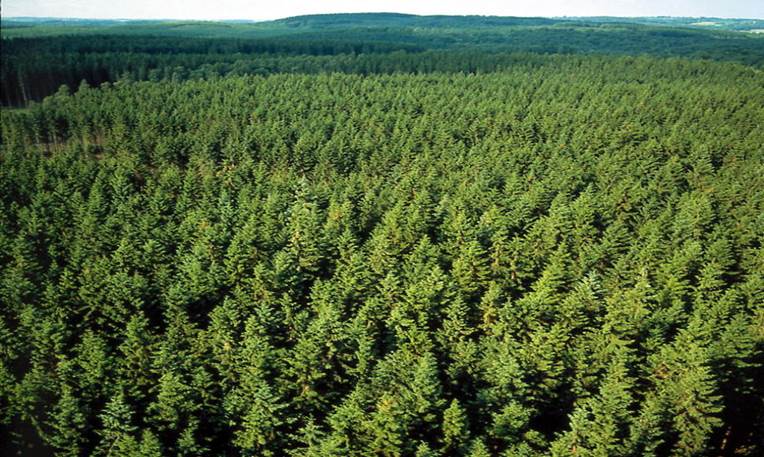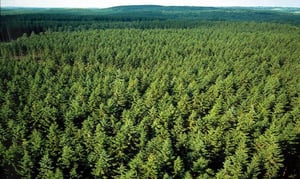3 min read
Forest Service Publishes Update Detailing the State of America’s Forests
John Greene
:
May 2, 2019

Stakeholders in the US forest supply chain must maintain a solid understanding of the general health, conditions and trends affecting America’s vast forest resources. Gathering this data is a tremendous undertaking on the part of the USDA’s US Forest Service (USFS), who works to compile the official statistics for all public and private forestlands throughout the country. The USFS then shares this knowledge by publishing the Forest Inventory and Analysis (FIA) Program, which is an invaluable tool used to inform policy, management and operational decisions throughout the US forest value chain.
(To make this data more readily available in digital format, Forest2Market recently launched the Timber Supply Analysis 360 tool on our interactive business intelligence platform, SilvaStat360, which provides fast, streamlined access to FIA data on growth, inventory and harvests. It also provides access to harvest data in the Pacific Northwest from the Bureau of Business and Economic Research, Oregon Department of Forestry and the Washington Department of Natural Resources. Timber Supply Analysis 360 is the only tool that allows you to access all this data in a single platform and in the units of measurement and scale that match your unique market needs.)
To that end, the USFS recently published Forest Resources of the United States, 2017, a document that provides forest resource statistics through 2017 and contributes to the 2020 Resources Planning Act (RPA) Assessment that provides current information on the nation’s forests. “Understanding the extent of the nation’s forest and woodland resources is the key to making informed policy and management decisions, whether at the local, state, national, or international scale,” said Forest Service Deputy Chief of Research and Development Alexander Friend.
Highlights from the recently-released report include:
Forest Statistics
- Forest and woodland area in the United States has plateaued at 823 million acres following decades of expansion. Forest land area alone occupies 766 million acres. Together, forest and woodlands comprise over one-third of the U.S. landscape and contain 1 trillion cubic feet of wood volume.
- While forest land is becoming more accessible to people and 67 percent of forest land is legally available for harvest activities, tree cutting and removal occurs on less than 2 percent of forest land per year. Contrast that with the nearly 3 percent disturbed annually by natural events like insects, disease, and fire.
- Wildfire, insects, and disease are among the biggest threats to forests and woodlands in the nation. Low harvest rates, aging forests, mortality from insect and disease infestations, and extreme weather events have com
 bined to create conditions that facilitate wildfire. Since 2012, mountain pine beetle damage increased by 1.1 million acres yearly.
bined to create conditions that facilitate wildfire. Since 2012, mountain pine beetle damage increased by 1.1 million acres yearly.
- While average annual mortality rates have increased nationwide over the last decade, mortality rates in the Rocky Mountains have doubled in that same timeframe as continuous drought, pine beetle events, and wildfires continue to plague the region. The heavy mortality rates are reflected in declining softwood volumes in the West.
- Disturbances and changing conditions on forested land are reflected in changes in tree species composition and distribution. Red maple, a species that responds positively to disturbances, is now the most numerous tree in the conterminous United States with a population estimate of 25 billion trees.
- National Forests, administered by the U.S. Forest Service, account for 35 percent of reserved forest land area, nationwide. Tree removals for products, fire management and land-use changes on national forests are very low and consume only 0.2 percent of standing volume on average, annually.
- Despite the low volume of wood extracted from national forests, average annual net growth (calculated as gross growth minus mortality) declined while average annual mortality nearly doubled from 2006-2016. These patterns reflect aging forests and combinations of wildfire, drought, and insect infestations.
Forest Industry Statistics
- Forest industry in the United States comprises 17 percent of global roundwood production, and the US has the highest intensity of industrial roundwood consumption per capita. The impact of the 2007 recession on wood product demand is still reflected in inventory data, with a 19 percent decline in Southern timber removals between 2006 and 2016. However, that trend should reverse as housing markets continue to recover.
- Bioenergy is an increasingly important industrial forest product. Wood energy accounts for 20 percent of all renewable energy and 41 percent of all bioenergy in 2016. Most of the wood energy that was used was manufactured by the wood products industry. In fact, the United States accounts for 26 percent total wood pellet production worldwide.
- Wood-processing facilities generated 4 million tons of mill residue in 2016, 99 percent of which was used for either fuel or fiber products like pulp and paper.
- The value of trees outside of forests continues to grow in importance as economic and public health data show that trees in the urban setting can reduce energy use for heating and cooling by $5.4 billion annually while producing 67 million tons of oxygen per year and sequestering 37 million tons of carbon.
The full 237-page report includes much more detailed regional and state information, statistics, graphs, charts, etc.





